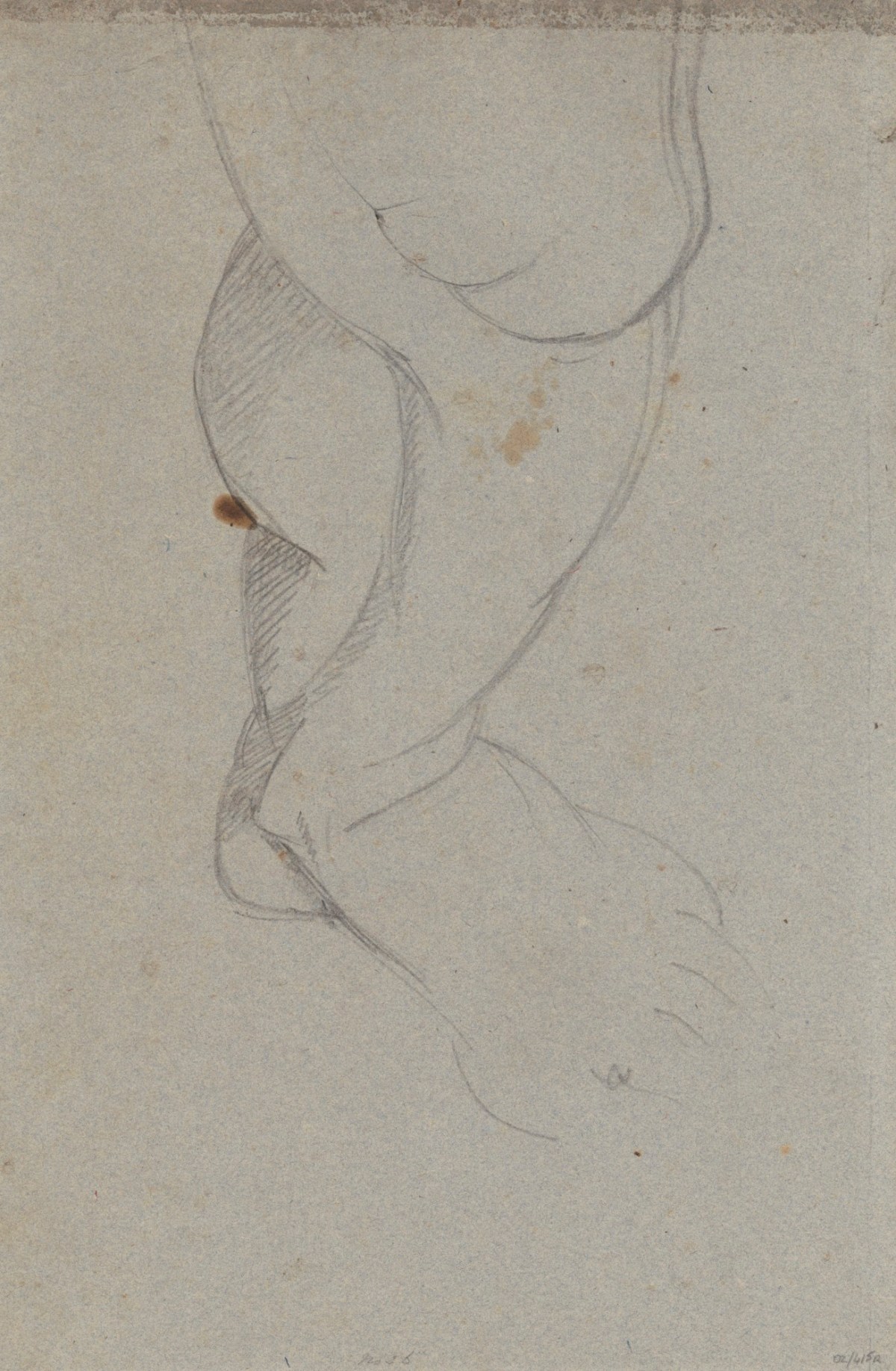
Benjamin Robert Haydon, Drawing of a leg from the knee down, ca. 1808-1812.
Black chalk on grey wove paper. 41.5 cm x 27 cm. © Photo: Royal Academy of Arts, London.
This image is not available to download. To licence this image for commercial purposes, contact our Picture Library at picturelibrary@royalacademy.org.uk
Drawing of a leg from the knee down, ca. 1808-1812
Benjamin Robert Haydon (1786 - 1846)
RA Collection: Art
These sketches relate to Benjamin Robert Haydon's painting 'Macbeth' (ca.1809-11; untraced). The painting is now lost but descriptions of the finished work by the artist and others indicate that it depicted Shakespeare's character just as he is about to murder King Duncan. 'Macbeth' was commissioned by the influential patron Sir George Beaumont and Haydon was at work on the composition by 1809. Unfortunately, he initially made the painting smaller than had been agreed then enlarged the canvas to such an extent that it could not fit into his patron's house, causing a serious rift in his relations with Beaumont.
Between 1809 - 1810 Haydon experimented with the composition. He first intended to show Macbeth in the act of stabbing Duncan but by May 1809 he had decided that 'it was such a common idea making him stabbing' and instead resolved to portray Macbeth 'grasping the clothes in one hand, the dagger in the other'. As he prepares to murder the King, Macbeth hears something 'and with terror and affright he looks around, and sees the shadow only of Lady Macbeth glimmering in dim half tints at the bottom of the room, the two grooms asleep at the foot of the bed and Duncan as sound and tranquil as if dreaming of Heaven'.
Haydon made copious studies for the 'Macbeth' painting. In 1810 he wrote; 'I advanced and fell back and advanced again; Macbeth's head I painted and repainted...I moulded torsos for the chest of Macbeth. I moulded knees for the sleeping grooms. I made studies without end; hands over and over again - from nature, from the antique. Models sat till night. My lamp often burnt deep into it.' Judging from the Royal Academy drawings, Haydon did make many studies of hands, legs and chests as well as compositional sketches and more specific studies for the figures. His models were Corporal John Sammons and a soldier named Dakin whom, Haydon recorded 'sat to me for the sleeping groom on his knees in Macbeth' and was later 'cut to pieces' at the battle of Waterloo.
Haydon's description of the finished painting suggests that he generally adhered to the concept he had formulated by May 1809 with a couple of significant changes. In the finished work, for instance, Macbeth holds daggers in two hands; 'his hands fixed and and grasping the daggers with supernatural clutching energy'. The grooms were also been moved from the bed to the foreground with Macbeth, in a dynamic pose, standing between them and the unfortunate King.
These drawings are studies for, or relating to, 'The Judgement of Solomon' (Plymouth Museum and Art Gallery) which Haydon painted between 1812-1814. The painting was first exhibited at the Oil and Water Colour Society, Spring Gardens 1814, and was purchased by Sir William Elford and J. W. Tingcombe for £735. While working on this painting Haydon became particularly interested in the Raphael Cartoons and the work of Michelangelo. He also studied Poussin, who painted this subject in 1649.
Haydon's diaries provide a considerable amount of information on his preparation for the 'Judgement of Solomon'. On the 8th April 1812 he wrote that, 'the mother should be as if she had burst out of her usual modesty; the moment she recollected herself she would blush'. In 1813 he recorded that the model for this figure was 'Patience Smith, a gipsy, about sixteen, with jet hair and brunette face - a perfect Raffaele. She sat for the young mother running off with her two children...She was a beautiful creature in figure as well as in face'. On the 3rd October 1812 Haydon noted that he had 'made an accurate drawing for the executioner from my old and faithful model, Sammons (who goes on Wednesday to Spain)…He sat for Macbeth and Dentatus, and has the cleanest wrists I ever saw'.
Object details
recto
41.5 cm x 27 cm
verso
27 cm x 41.5 cm



